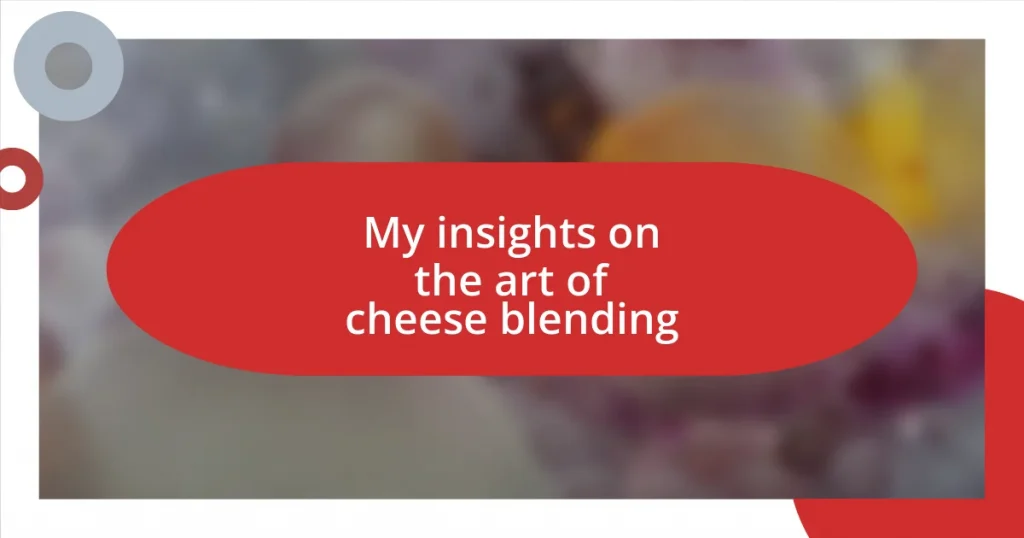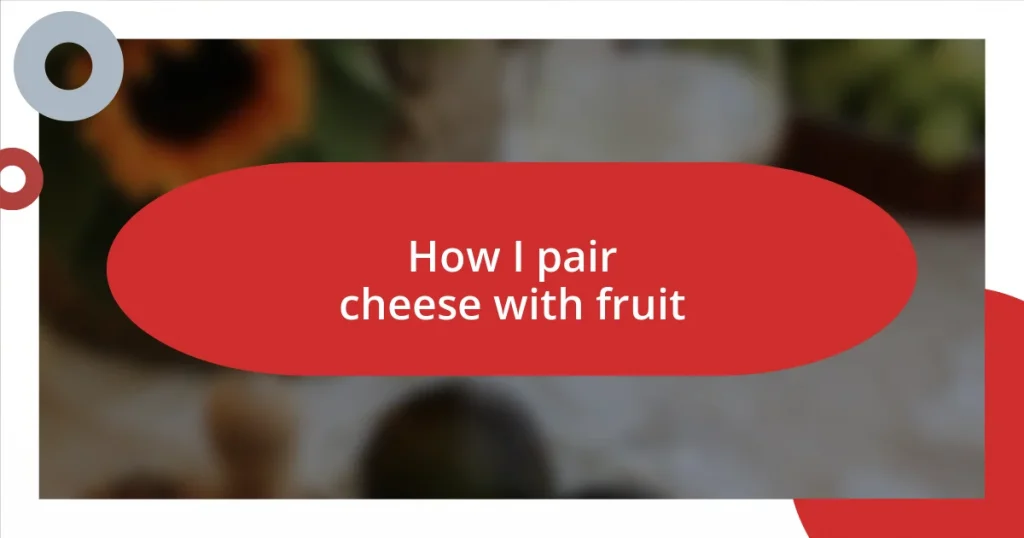Key takeaways:
- Cheese blending is about finding harmony in flavors and textures, utilizing complementary and contrasting elements for an enjoyable experience.
- Factors such as the type of milk, aging process, and microbial cultures significantly influence the flavor profile of cheeses.
- Successful blending involves considering texture combinations, serving temperature, and using complementary flavors like fruits and herbs to enhance the overall tasting experience.
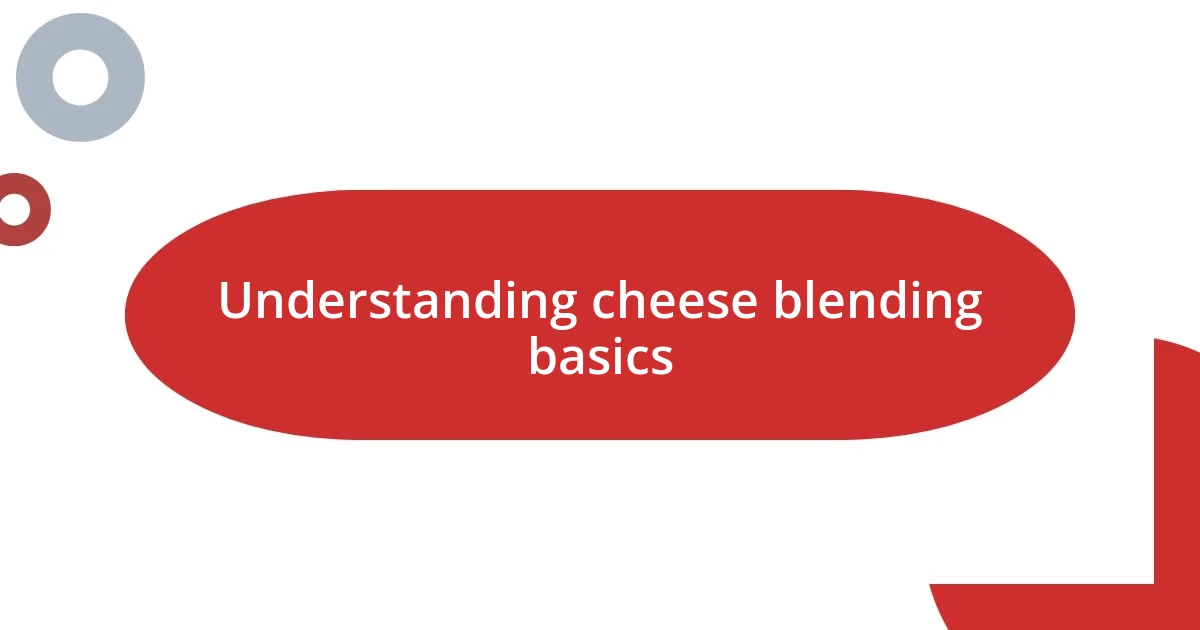
Understanding cheese blending basics
Cheese blending is an art that goes beyond mere combination; it’s about finding the perfect harmony of flavors and textures. I remember my first attempt at blending cheeses for a party; I was nervous but thrilled to experiment. The combination of a sharp cheddar with a creamy brie was a delightful surprise, creating a contrast that many of my friends raved about. Have you ever experienced that exhilarating moment when flavors unexpectedly sing together?
When blending cheeses, it’s vital to consider both complementary and contrasting elements. I often think about whether to pair a nutty Gruyère with a tangy goat cheese or maybe throw in a smooth blue cheese for depth. What makes these combinations feel magical? It’s about balancing richness with acidity, and texture with creaminess, ensuring every bite is a pleasure.
Don’t forget the importance of temperature; cheese should be at room temperature to allow its flavors to fully develop. I learned this lesson the hard way at a gathering where I served chilled cheese. The flavors just didn’t pop as they should have! Ensuring the right serving conditions can transform a good blend into an unforgettable experience. What moments have you had with cheese that surprised you?
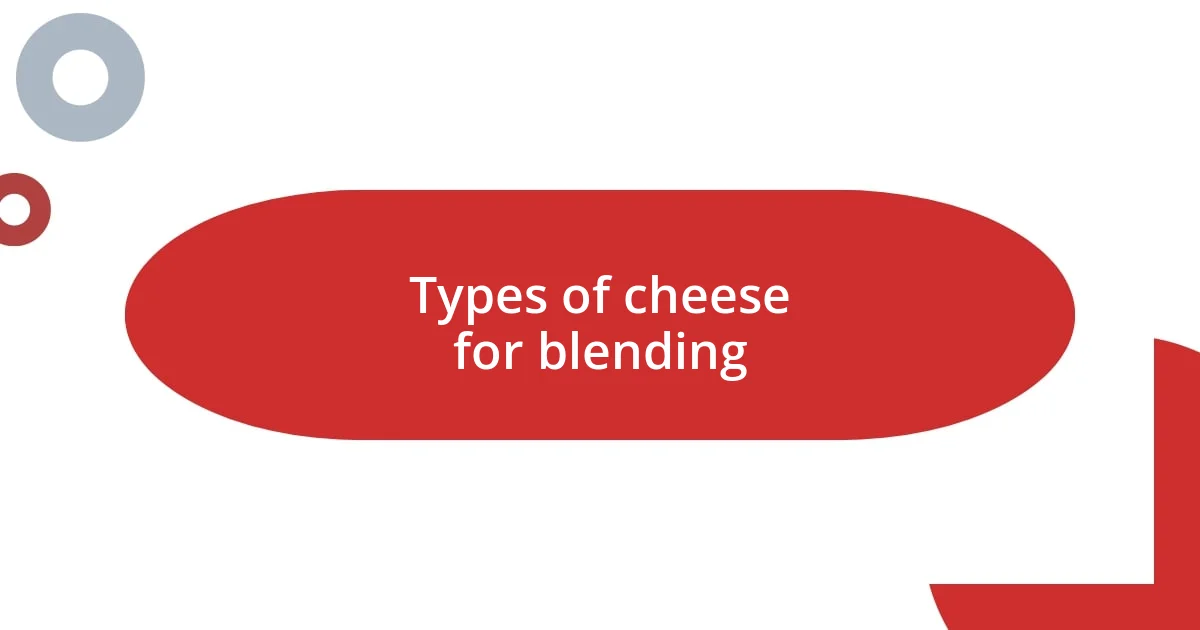
Types of cheese for blending
When I think about types of cheese for blending, a few favorites always come to mind. It’s fascinating how different qualities interact, like the creamy texture of a fresh mozzarella alongside the sharpness of aged gouda. On one occasion, I decided to use a crumbled feta with a rich cheddar in a mac and cheese recipe. The results were so satisfying that it quickly became my go-to combination for potlucks. The union of tanginess and depth brought smiles all around!
- Cheddar: Bold and versatile; works beautifully with creamy textures to balance richness.
- Brie: Soft and luscious; its smoothness enhances the overall mouthfeel and complements sharper cheeses.
- Goat Cheese: Tangy and fresh; perfect for adding brightness and cutting through richer flavors.
- Gruyère: Nutty and slightly sweet; brings depth and complexity to blends, especially with bold flavors.
- Parmesan: Hard and salty; a little goes a long way in adding umami and bringing harmony to milder cheeses.
- Blue Cheese: Strong and pungent; adds an unexpected kick, elevating simpler blends to gourmet status.
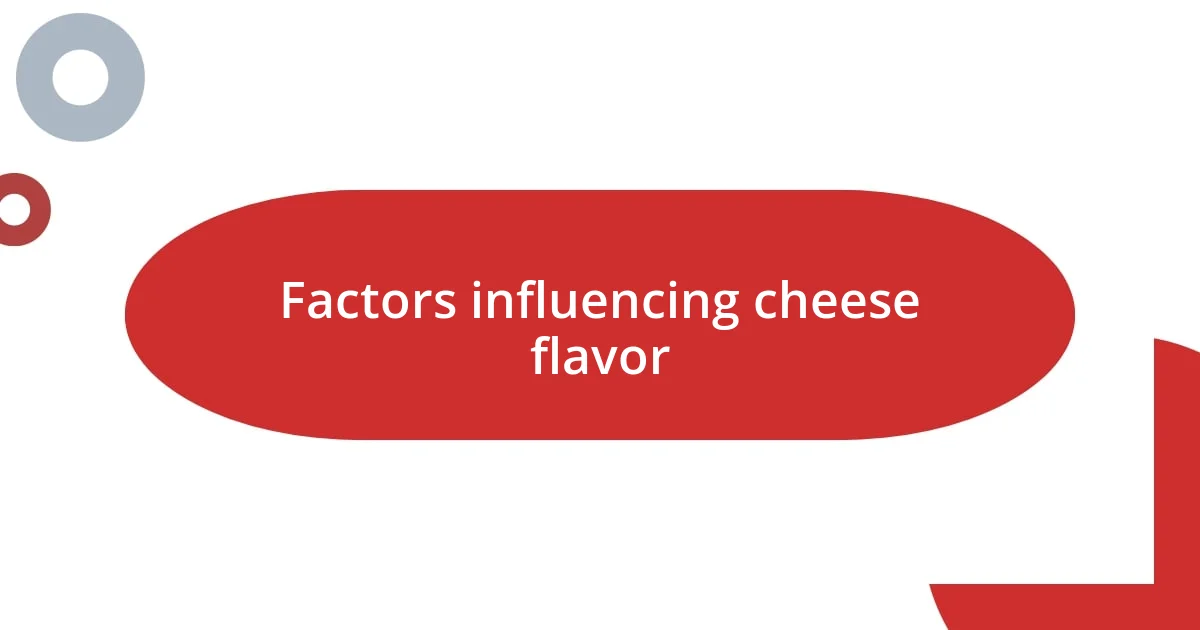
Factors influencing cheese flavor
The flavor of cheese is influenced by several key factors. One significant element is the type of milk used. I have always been drawn to the unique flavors that can be produced from cow’s, goat’s, or sheep’s milk. For instance, goat cheese often has that delightful tanginess that pairs beautifully with sweeter varieties, creating a wonderful juxtaposition on the palate. Have you ever noticed how the same cheese can taste different depending on its source?
Another factor to consider is the aging process. I recall tasting an aged cheddar that had complex, caramel notes, while a younger version was crisp and sharp. This difference can completely change the impact of your cheese blend. Age not only amplifies flavors but can also create a texture that enhances the overall experience. Don’t you find it intriguing how such small changes can lead to completely different taste profiles?
Furthermore, the influence of microbial cultures shouldn’t be overlooked. I often marvel at how various bacteria and molds contribute to the diverse flavors. There was a memorable occasion when a friend introduced me to a blue cheese rich in earthy notes, which had been developed using a specific culture. The depth of flavor was astounding and made me rethink how I approach blending. How do you feel about the role of these cultures in shaping cheese character?
| Factor | Description |
|---|---|
| Type of Milk | Cow, goat, and sheep milk each impart unique flavors; goat’s milk is typically tangy, while cow’s milk can be creamy. |
| Aging Process | The duration of aging influences flavor complexity; older cheeses often develop deeper, richer notes. |
| Microbial Cultures | Different cultures introduce unique flavor profiles, as seen in varieties like blue cheese which are enhanced by specific molds. |

Techniques for successful blending
When it comes to successful cheese blending, I believe choosing the right combination of textures is key. For example, I once experimented with a blend of creamy burrata and sharp aged provolone in a salad. The contrast not only added visual appeal but also made each bite a delightful experience; the creaminess balanced the sharpness perfectly. Have you ever felt that sensation when flavors complement each other so well that it elevates the entire dish?
Another technique that I’ve found invaluable is to layer flavors as you build your blend. I often start with a base cheese, like a mild ricotta, and gradually introduce more assertive tastes like blue cheese. This layered approach allows the flavors to meld harmoniously rather than overpower one another. Have you tried blending cheeses gradually to see which profile emerges best for your palate?
Lastly, it’s essential to consider the temperature of your cheeses when blending. Serving cheeses at room temperature can significantly enhance flavor, as I learned during a cheese tasting with friends. We left the cheeses out for about an hour, and the richness of a nice camembert really blossomed. Isn’t it amazing how something as simple as temperature can unlock hidden nuances in your cheese blends?
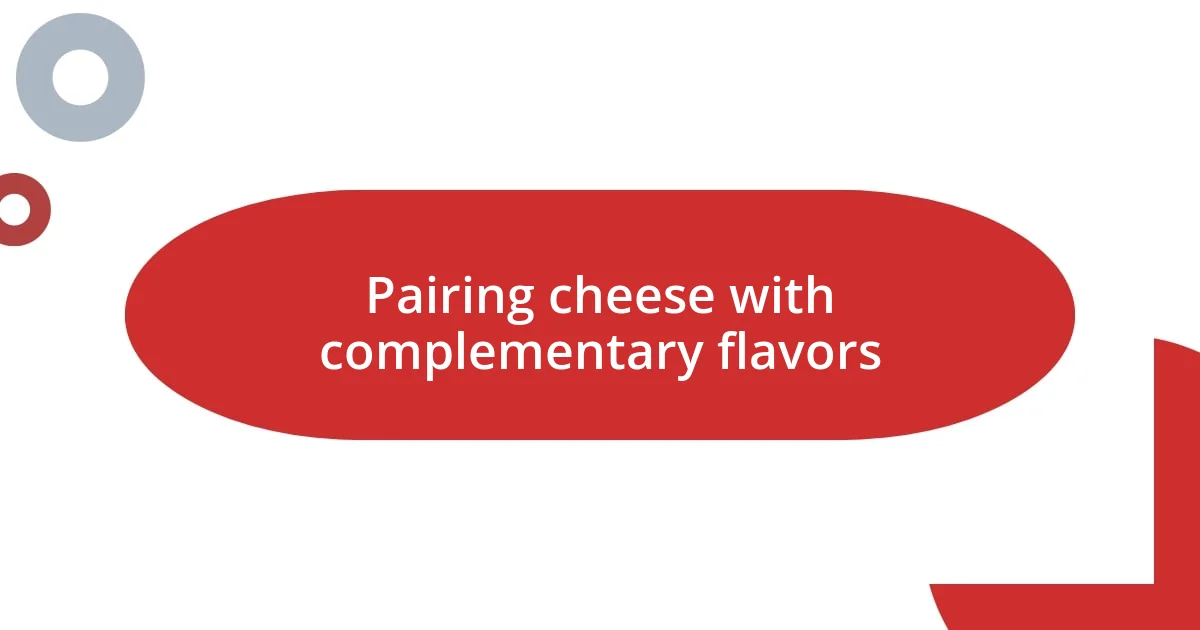
Pairing cheese with complementary flavors
When I think about pairing cheese with complementary flavors, I recall an evening spent experimenting with a variety of chutneys and cheeses. That moment taught me the magic of sweet and savory. A creamy Brie combined with a tart cranberry chutney was astonishing; the sweetness brightened the cheese’s rich texture. Have you ever tasted a combination that transformed your expectations of how cheese can be enjoyed?
Exploring different herbs and spices can also elevate cheeseboard experiences. I remember adding fresh rosemary to a soft goat cheese, and instantly, the earthy notes of the herb complemented the cheese’s tanginess. The synergy created this inviting depth that I had never encountered before. It made me wonder how the inclusion of unexpected ingredients could open so many doors to new flavor explorations.
Fruit is another remarkable partner for cheese. I once paired aged gouda with slices of ripe pear, and the combination was nothing short of divine. The creamy, nutty flavors of the cheese mingled beautifully with the sweetness of the fruit. Don’t you find it fascinating how a simple addition can elevate the entire tasting experience? I encourage everyone to try experimenting—there’s a whole world of flavor waiting to be uncovered!
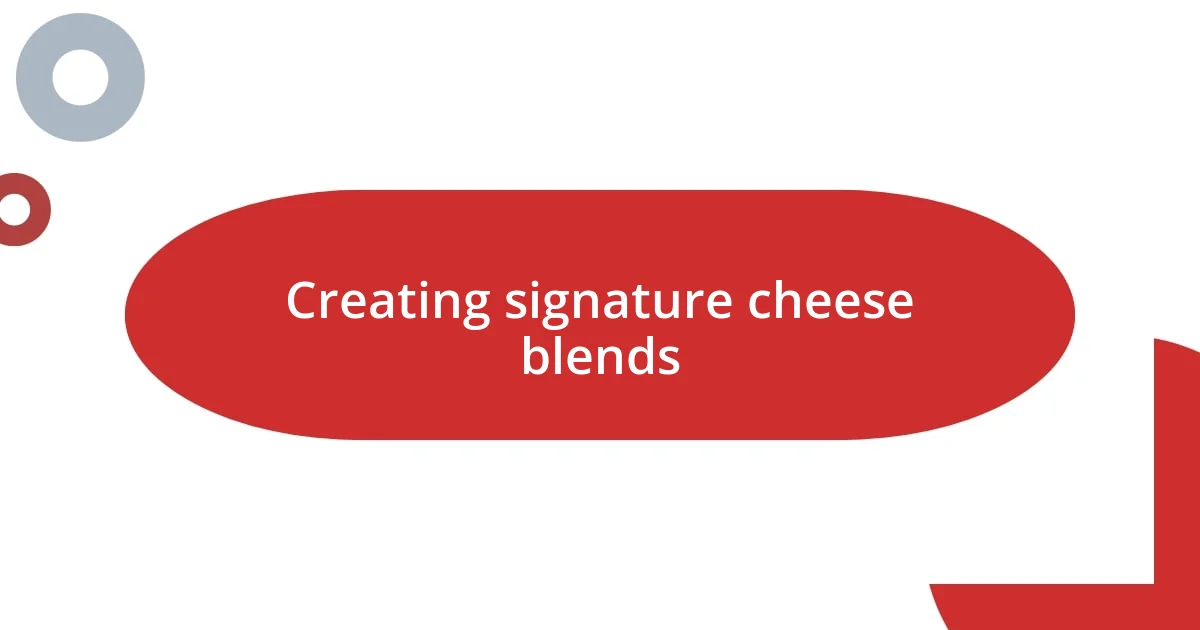
Creating signature cheese blends
Creating a signature cheese blend is a creative adventure that taps into personal taste and imagination. I remember hosting a small gathering where I decided to craft a distinctive blend using smoked gouda, tangy feta, and creamy mascarpone. The smoky notes from the gouda added depth, while the feta’s saltiness provided a delightful contrast. The richness of mascarpone tied everything together, creating a harmonious blend that surprised my guests. Have you ever created something uniquely yours that left a lasting impression on those around you?
The blending process is also about discovering textures that complement each other. I once dabbed into mixing a firm cheddar with a crumbly blue cheese, and it was a revelation! The firmer cheese created a satisfying bite, while the blue cheese crumbled effortlessly, leaving a lingering taste that made each nibble exciting. This dual texture not only intrigued my palate but also sparked conversations about our own cheese preferences. Isn’t it wonderful how a new combination can lead to such delightful revelations?
In forming your signature blends, don’t shy away from bold choices. One day, inspired by a recent trip to a winery, I fused a robust goat cheese with a splash of honey and a sprinkle of chili flakes. That unexpected flavor explosion was electrifying! It highlighted the importance of daring to experiment; sometimes, the most memorable blends come from a leap of faith. Have you taken that leap yet? It just might lead you to your perfect cheese creation!
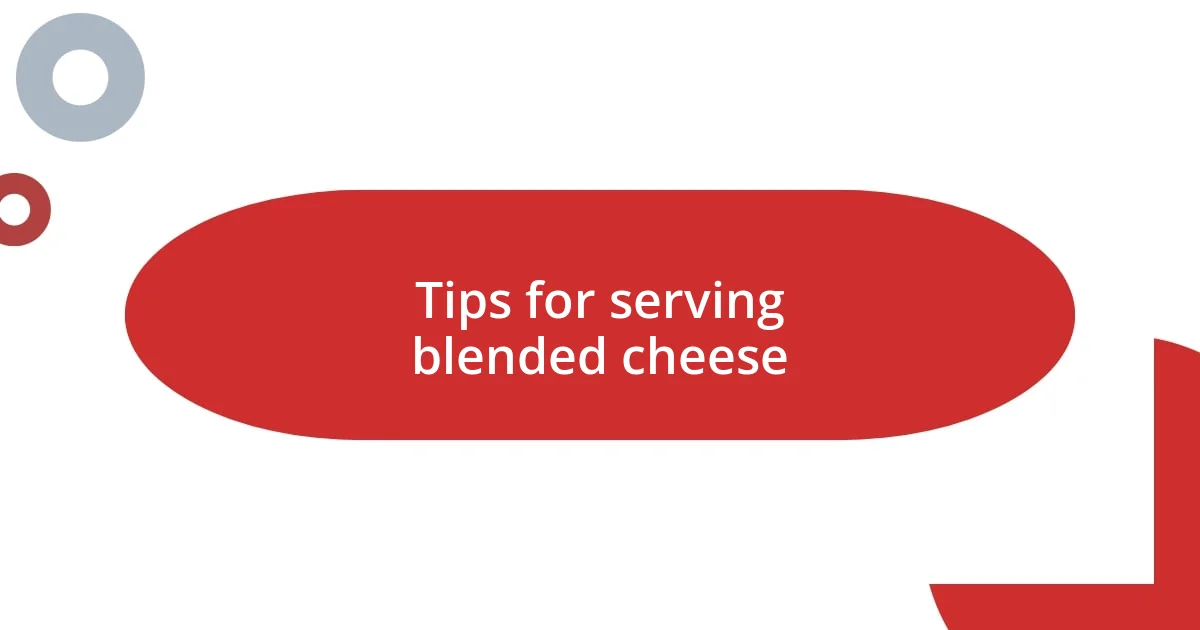
Tips for serving blended cheese
When it comes to serving blended cheese, presentation matters just as much as flavor. I still remember the first time I arranged a cheese platter with vibrant colors and contrasting textures. Using slate boards and decorative cheese knives not only elevated the look but also invited eager hands to dive in. Have you considered how the visual appeal can set the mood for an enjoyable tasting experience?
To enhance flavor profiles, I recommend serving your cheese at room temperature. Once, I served a beautifully blended cream cheese and aged cheddar mix straight from the fridge, and the flavors fell flat. However, letting it sit out for about 30 minutes transformed it! The creaminess became more pronounced, and every bite was bursting with taste. What if you experimented with other cheeses at room temperature?
Lastly, don’t underestimate the power of accompaniments. I once paired my signature blend with homemade jalapeño jelly, and it was a showstopper! The sweet and spicy notes complemented the cheese beautifully, creating a memorable experience for my guests. Have you ever thought about how a simple side can elevate your cheese offering to new heights?










